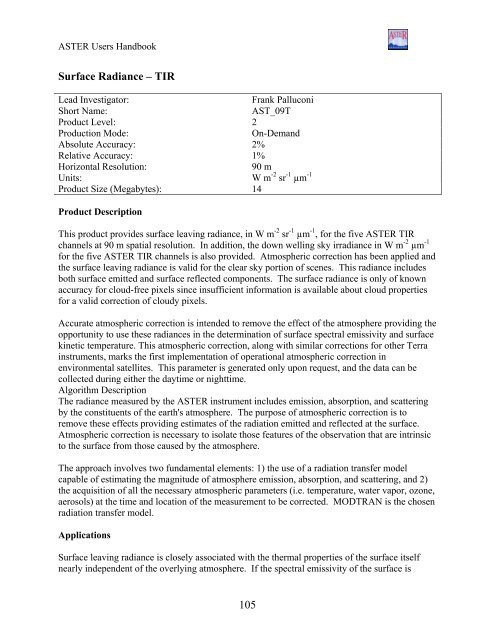You also want an ePaper? Increase the reach of your titles
YUMPU automatically turns print PDFs into web optimized ePapers that Google loves.
<strong>ASTER</strong> Users HandbookSurface Radiance – TIRLead Investigator:Frank PalluconiShort Name:AST_09TProduct Level: 2Production Mode:On-DemandAbsolute Accuracy: 2%Relative Accuracy: 1%Horizontal Resolution:90 mUnits: W m -2 sr -1 µm -1Product Size (Megabytes): 14Product DescriptionThis product provides surface leaving radiance, in W m -2 sr -1 µm -1 , for the five <strong>ASTER</strong> TIRchannels at 90 m spatial resolution. In addition, the down welling sky irradiance in W m -2 µm -1for the five <strong>ASTER</strong> TIR channels is also provided. Atmospheric correction has been applied andthe surface leaving radiance is valid for the clear sky portion of scenes. This radiance includesboth surface emitted and surface reflected components. The surface radiance is only of knownaccuracy for cloud-free pixels since insufficient information is available about cloud propertiesfor a valid correction of cloudy pixels.Accurate atmospheric correction is intended to remove the effect of the atmosphere providing theopportunity to use these radiances in the determination of surface spectral emissivity and surfacekinetic temperature. This atmospheric correction, along with similar corrections for other Terrainstruments, marks the first implementation of operational atmospheric correction inenvironmental satellites. This parameter is generated only upon request, and the data can becollected during either the daytime or nighttime.Algorithm DescriptionThe radiance measured by the <strong>ASTER</strong> instrument includes emission, absorption, and scatteringby the constituents of the earth's atmosphere. The purpose of atmospheric correction is toremove these effects providing estimates of the radiation emitted and reflected at the surface.Atmospheric correction is necessary to isolate those features of the observation that are intrinsicto the surface from those caused by the atmosphere.The approach involves two fundamental elements: 1) the use of a radiation transfer modelcapable of estimating the magnitude of atmosphere emission, absorption, and scattering, and 2)the acquisition of all the necessary atmospheric parameters (i.e. temperature, water vapor, ozone,aerosols) at the time and location of the measurement to be corrected. MODTRAN is the chosenradiation transfer model.ApplicationsSurface leaving radiance is closely associated with the thermal properties of the surface itselfnearly independent of the overlying atmosphere. If the spectral emissivity of the surface is105















